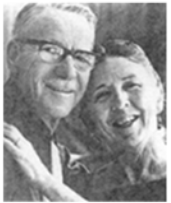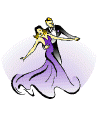|
|
When the Words Began To Change
by Sandi
& Dan Finch
It was an invasion of sorts -- the arrival of British dance teachers in
New York and Los Angeles in the early 1960s. They brought with them
their “International” style of ballroom dancing and their book of
formalized terms that had been developing since the mid-1920s.
At the time, there was yet no Roundalab (RAL). A universal round dance
standard was at least 15 years away.
Round dance leaders began taking lessons from the English coaches, only
a few at first, but they incorporated what they were learning into
dances, silently revolutionizing round dancing. At first it was the use
of new formal cue terms. Being able to dance the new figures also
required a new approach. Footwork became more important -- you couldn’t
just “step”; you needed to use heel leads where appropriate. You had to
“dance” your body as well as your feet to handle much of the rotation.
This didn’t sit well with much of the round dance establishment. Round
dancing had been more akin to folk dancing, where steps were taken on
the ball of the foot. The February 1984 Roundalab Journal described
receipt of a petition signed by “several hundred” dancers and teachers
asking RAL not to shift to the new advanced styling. The RAL chairman
noted that the RAL Manual had been called the “International Round
Dance Standard” to convey the global membership of the organization,
not the adoption of the international style, but the word
“international” was dropped from the manual cover. The document today
is simply called the Manual of Standards.
Even as late as 2013, there was controversy over the re-naming of a
phase III Rumba figure. It was going by the name of “Door” because of
its similarity to the Two Step figure by that name. The Rumba figure,
however, is a variation of the Rumba cucaracha and should be danced
with Rumba hip action, so it made more sense to call it “Cucaracha
Cross.” Door remains the name of the Two Step figure. As Roundalab
Standards chairman at the time, I was challenged with an echo from the
past by one phase III teacher who asked “aren’t you advanced dancers
ever satisfied?”
In 1972, an outrageously new and different Foxtrot, Maria Elena, had
been released, one of the first to incorporate the new International
terms. Some teachers refused to teach it. Some cued it with step cues.
Even as late as 1984, when Frank Lehnert released his book
“Step-Close-Step: Round Dance Basics for Dancers, Teachers, Callers,”*
he included one version of Maria Elena using step cues and one using
International cue words. “Getting used to ballroom terminology is a
whole new ballgame,” he wrote, “and one should decide your goals and be
satisfied with the direction you take.”
Frank and Phyl Lehnert, from Ohio, taught round dancing
internationally, were early members of Roundalab and URDC (which became
ICBDA), and ran a teacher’s school.
Foxtrot even today is taught at Phase III using Waltz figures to get
across the Foxtrot timing. That means at Phase III, for example, you
learn the term “forward, run 2,” which you will re-learn as “Three
Step” when you get to Phase IV.
 Maria Elena would eventually become a RAL Golden Classic and ICBDA Hall
of Fame dance. But in 1975, the choreographers, Nina & Charlie Ward
(ICBDA 1981 Golden Torch recipients; pictured), felt compelled to write
an article for Round Dancer Magazine (December 1975 edition) explaining
the dance to help it get more widely accepted.
Maria Elena would eventually become a RAL Golden Classic and ICBDA Hall
of Fame dance. But in 1975, the choreographers, Nina & Charlie Ward
(ICBDA 1981 Golden Torch recipients; pictured), felt compelled to write
an article for Round Dancer Magazine (December 1975 edition) explaining
the dance to help it get more widely accepted.
Nina said she chose to use the International figure “promenade zig zag”
because she liked it and because dancers would relate it to the old
round dance term “vine.” “We used the most basic figures, with a few
exceptions,” she wrote. “We had an excellent piece of music and we
followed the International format. It was introduced fortunately at the
right time, at the right place, to interested dancers -- a combination
of luck and industry.”
As related in a later Round Dancer Magazine (March 1978 edition), she
had been taking International ballroom lessons and wrote Maria Elena
for teaching purposes. But in January 1972, the Wards used it as a demo
at a festival where the Highburgers were the featured teachers. It was
such a rage, the Highburgers gave up one of their teaching spots so the
Wards could teach the demo.
“That surely must have been one of the most exciting sessions in round
dancing,” the magazine wrote. “This beautiful challenging rhythm -- so
new and strange to us as round dancers -- but we had to master it . .
. Word got around and what a furor of controversy there was at
the time, but it was the start of a new era in round dancing.”
Part A of the original Maria Elena cue sheet starts like this: “Whisk;
Fwd,-,2,3; Fwd,-,side, back; Back,-,side, fwd,; Fwd,-,2,3;” Translated
into International terms, this becomes: “Whisk; Feather; Reverse Turn;;
3 step;” Later versions of the cue sheet added other International
terms: “half natural,” “outside swivel”, “top spin” and “zig zag,”
which had not existed in any round dance lexicon.
Maria Elena was one of three Golden Classics picked for a quick review
of their “gotchas” at this year’s Roundalab convention. Maria Elena
challenges us with split measures. In Part B, you dance reverse turn
check and weave (three full measures), followed by three step (full
measure) and a slow forward (two beats). At the end of Part C: Thru to
zig zag (one and a half measures) to three Step (full measure) and slow
forward (another half measure). Still a teaching topic, after all these
years.
*We are grateful to Zena Beaulieu for sending the Lehnert book our way
in a box of historical round dance material (originally from Ellen
Wheelock) to add to our resource library.
From a club
newsletter, July 2022,
and
reprinted
in the Dixie Round Dance Council (DRDC)
Newsletter, August 2022. Find a DRDC Finch archive here.

|
